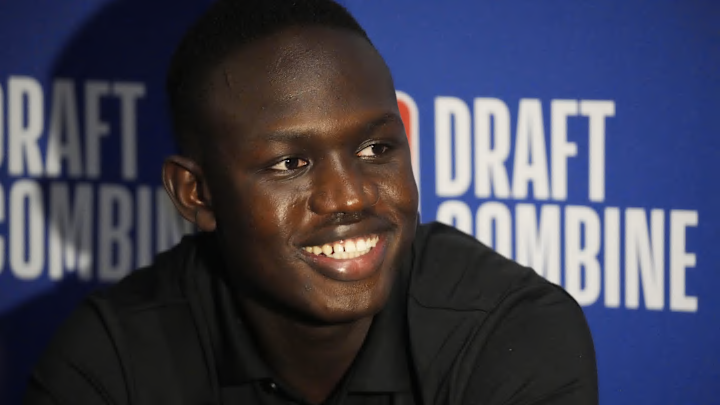The Portland Trail Blazers had just a 3.7 percent chance at Cooper Flagg, but history repeated itself as they missed out on a potential franchise savior by one final lottery combination. With Flagg shockingly headed to Dallas, the Blazers will now need to shift their focus to the ten prospects on the board after the Duke phenom.
One dream target should be Flagg's teammate, Khaman Maluach.
His stock should only continue to rise after an impressive combine, showcasing his ability to knock down the three-ball and recording measurements comparable to Rudy Gobert, a four-time Defensive Player of the Year.
Maluach is the ideal modern-day center and would make the Blazers terrifying defensively between him and Donovan Clingan. If the two continue to improve their shot, there's even a scary thought of them playing alongside each other, especially with the comeback of the two big lineups in this year's playoffs.
But unfortunately, Maluach falling to the Blazers at No. 11 appears to be a pipe dream. At the rate he's ascending, it wouldn't be all that surprising if he's even a top-five pick by the time the draft rolls around.
But at the very least, a team in the six to ten range seems likely to take a flier on Maluach. This draft is the opposite of last year when Clingan slipped to the Blazers at No. 7 because teams ahead of them already had centers. Houston, Toronto, Brooklyn, New Orleans, and Washington all need a defensive anchor and could look to bolster their frontcourt in the draft.
So, if it's not Maluach, who else makes sense for the Blazers at No. 11?
Derik Queen, Maryland
Offensively, Queen is the most skilled big man in the entire class, with a unique skill set that includes uncanny ballhandling and playmaking for someone who's 6-foot-10.
His game is similar to Houston's Alperen Sengun in terms of strengths (footwork and passing) and weaknesses (lack of shooting, athleticism, rim protection). That's still an All-Star-level comparison, but it does raise the question of what his role looks like on a contending team.
Queen's upside outweighs his fit here for the center-heavy Blazers, especially if Clingan can continue to improve his three-point shot.
Egor Demin, BYU
Demin's stock could also skyrocket after a historic NBA combine. He came in at 6'8 1/4" barefoot with a wingspan of 6'10 1/4", which is the tallest guard ever measured at the combine.
His positional versatility is perfect for the identity that general manager Joe Cronin has been emphasizing. It also allows him to be a combo guard, providing insurance for the Blazers' messy backcourt. If Anfernee Simons gets traded or one of Scoot Henderson/Shaedon Sharpe doesn't pan out, Demin can slide in wherever is needed.
He does need to improve his shooting (27.3 percent from three), but the Blazers can afford to be patient with his development and bet on the upside here with Demin's elite measurements.
Kasparas Jakucionis, Illinois
The reasons for taking Demin also apply to Jakucionis. His 6-foot-6 frame projects to be a combo guard at the next level, but he has a higher floor and is a better fit than Demin because he's a more reliable shooter.
These appear to be realistic targets for the Blazers to consider at No. 11, with Queen and Jakucionis both being selected in two of their five post-lottery mock drafts. Of the three options, Jakucionis stands out as the ideal fit, given Portland's uncertain backcourt situation and his higher floor.
We don't exactly know how Queen is going to fit into the NBA with his tweener status, poor combine results, and lack of shooting. But he could also very well be the type of player who is special enough to make others have to adapt to his style of play. For Demin, the two things keeping him from being over Jakucionis are his shooting and ability to create separation as a ballhandler.
Nonetheless, all three are great options. Even if Maluach is off the board, the Blazers are still in a great spot in what projects to be a strong draft.
